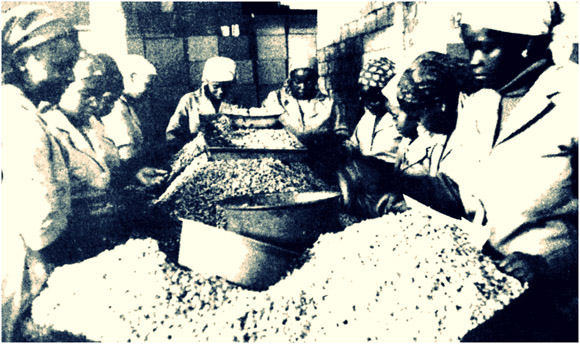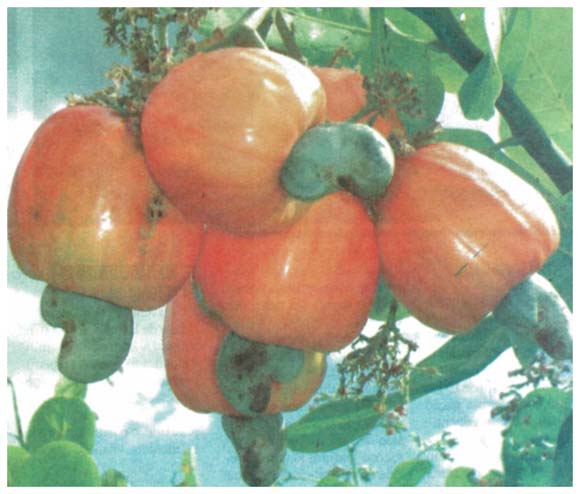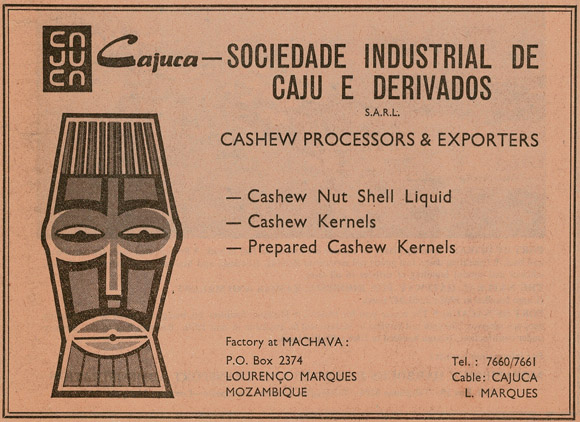Agriculture: The Cashew Industry,
1969-1994
Dossier MZ-0088
![]()


Above top: Mozambican women working in a factory processing cashew, date unknown. Below: the colourful cashew apple and seed (or nut).:
The term “cashew” (Portuguese caju) refers to the fruit and seed of a tropical evergreen tree that was an important commercial crop in Mozambique until the collapse of the industry under the twin impact of the war with RENAMO, and subsequent ill-advised policies imposed by the World Bank. Cashew seeds (usually called nuts) are popular worldwide as a high-value luxury snack and for use in cuisine; the fruit (the cashew apple), high in vitamin C, can be used to make a drink.
In the late colonial period, Mozambique was a major world producer of cashew. In the 1950s and 1960s the country had several processing factories, but by the early 1980s they had almost all been abandoned. Nevertheless, both the colonial and post-independence governments protected local processing (with first a ban and then a tariff on the export of raw nuts). In the 1980s production collapsed during the catastrophic conflict with RENAMO, which displaced large numbers of rural people. When the conflict ended, levels of production did not recover, partly because the stock of cashew trees had aged and needed to be replaced.

Above: An advertisement for the Portuguese colonial cashew marketing company Sociedade Industrial de Caju e Derivados or CAJUCA, published in August 1969.
Additionally, In the mid-1990s, the World Bank intervened to demand a change of policy, believing that the government was effectively subsiding the industry (for details, see Joseph Hanlon, “Power without responsibility: the World Bank and Mozambican cashew nuts" Review of African Political Economy vol. 27, no. 83, 2000, p.29-45 for details [subscription required]). The bank’s position was based on a consultancy report that both the local Associação dos Industriais de Cajú and the government criticised strongly for inadequate data collection and lack of consultation. However, the policy was imposed on Mozambique, with the end result that about 10,000 workers lost their jobs in processing, and small-scale farmers producing cashew lost much of their income.
Eventually the World Bank admitted its error, and by 2006, according to government sources, the cashew industry had recovered to some extent (although large, mechanised factories were a thing of the past).
For two detailed book-length studies of the cashew industry in Mozambique, see Fernando Bessa Ribeiro, Entre martelos e lâminas: dinâmicas globais e políticas de produção na indústria do caju em Moçambique (Porto: Afrontamento, 2010); and Jeanne Penvenne, Women, migration and the cashew economy in southern Mozambique (Woodbridge, Suffolk: James Currey, 2015).
![]()
Click on the yellow folder image below to download a zipped archive of the dossier, consisting of 119 documents and press clippings in PDF format concerning the cashew industry. Note that new items will be added to this dossier from time to time. This version is dated 10 March 2021
![]()



![Aluka: Struggles for Freedom [subscription required] Struggles for Freedom](imgs/aluka_200.png)



